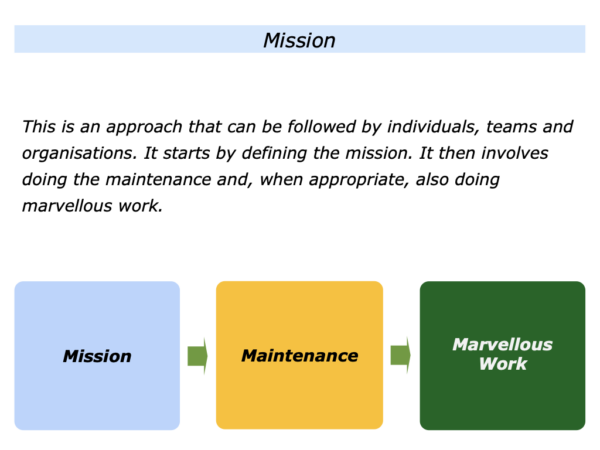
There are many ways to do fine work. This is an approach that can be followed by individuals, teams and organisations.
Let’s start with you as an individual. You may want to begin by defining the mission. This can be something you want to do or deliver in your personal or professional life.
The next step will be to do the maintenance. These are the necessary tasks that must be done. When appropriate, you may also do marvellous work to deliver the mission.
Looking back, can you think of a situation when you followed some of these steps in your own way? What were the strategies you followed? How did you translate these into action? What happened as a result of taking these steps?
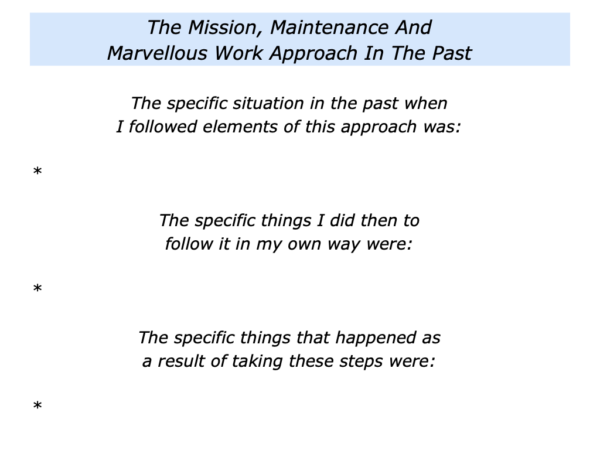
Imagine that you want to follow some of these steps again in the future. You may want to do this as an individual or when leading a team. Let’s explore how to make this happen.
The Mission
The approach starts by defining the mission. This may be philosophical, practical or focus on delivering positive results. Some missions combine all these elements. Here are some missions that people may aim to achieve.
The Mission
I want to follow my spiritual faith … I want to use my strengths to help people to succeed … We want to ensure that every child has access to a laptop … We want to pioneer a new way of doing business in our field … We want to create a vaccine for Covid.
People love to have a sense of mission. They love to feel they are contributing towards achieving something worthwhile. This can provide a sense of meaning to their lives and work.
Charles Garfield, the author of Peak Performers, said that people are driven by a sense of mission. A clinical professor of psychology, he saw this approach in action when he led a team of engineers, scientists and support staff on the Apollo 11 project.
Charles said that people, teams and organisations mobilise great strength when pursuing motivating missions. People want to serve a cause, follow their vocation or deliver a stimulating project. He wrote:
People want to feel proud of themselves, to achieve something, to leave a mark and a contribution, and they follow their plans for doing all that purposefully and tenaciously.
The most powerful human motivator of all is the desire to be proud of ourselves in the pursuit of something we care about deeply.
Imagine that you want to take this approach as an individual. You may want to write an article, renovate a house, create a self-help group for recovering patients or do another activity.
Imagine you want to take this approach when leading a team. Your team may aim to find a cure for a disease, solve a pressing problem, build an innovative product or deliver a worthwhile project.
Different people have different views of what constitutes a mission. Military missions, for example, must often meet the following criteria.
They must have an achievable objective, a strategy what will work, the required resources, a specific time frame and a clear exit strategy.
Military people then know what they must achieve by a certain date. It is also vital to have an exit strategy or, in some cases, a transition strategy.
Susan Ward produced an excellent definition regarding mission statements which is reproduced below.
A mission statement is a brief description of a company’s fundamental purpose. It answers the question, “Why does our business exist?”
The mission statement articulates the company’s purpose both for those in the organization and for the public.
Let’s return to your own life and work. What is the mission you as an individual would like to pursue? What are the key strategies you can follow to give yourself the greatest chance of delivering the mission?
What are the specific things that will be happening that will show you have delivered the mission? What will be the benefits – for yourself and for other people – of pursuing this mission?
If you wish, try tackling the exercise on this theme. This invites you to complete the following sentences.
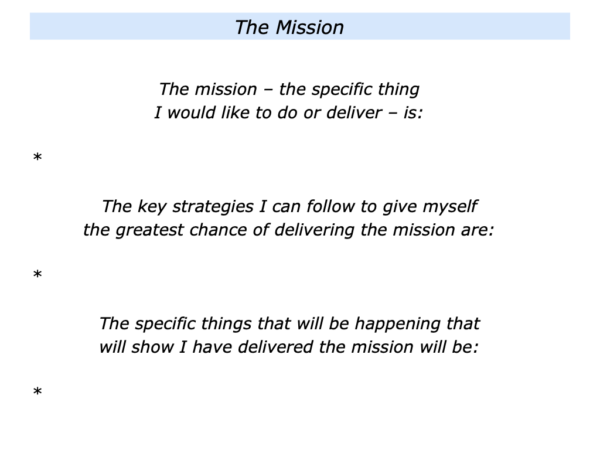
The Maintenance
Imagine you have defined your individual mission. The next step is to make sure the maintenance gets done. This provides the platform for delivering the mission.
You will have your own approach to making sure these tasks get done. One approach is:
To keep pursuing the strategies most likely to deliver the mission;
To keep making sure all the necessary tasks get done;
To keep delivering consistently high standards.
Good leaders take a similar approach in teams. They recognise they are accountable for delivering the mission. They often have mission holders, however, who take responsibility for achieving aspects of the goals.
Imagine that you want to take this approach when leading a team. Who are the people you would like to be mission holders for aspects of the plan?
Many mission holders will be duty driven and already doing good work. They may need people to take over some of their current duties. This will release them to take the extra responsibility.
Mission holders will need to keep you informed, but they need to be given the authority and autonomy required to deliver the goods. Here are some things to bear in mind when considering who can play this role.
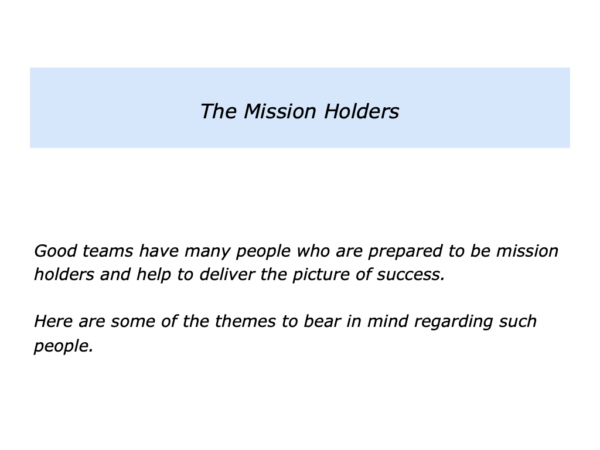
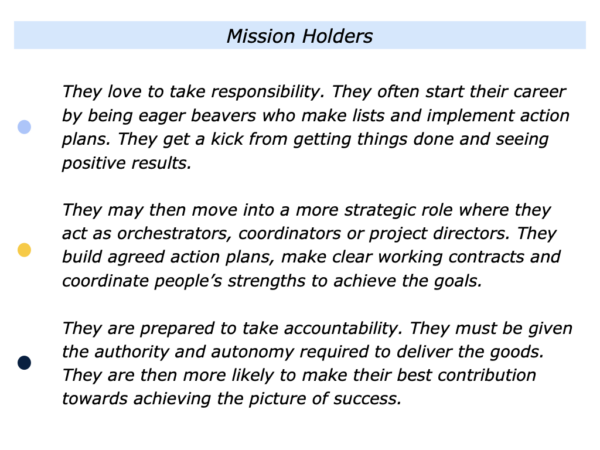
Imagine you have clarified who you want to be the mission holders for aspects of reaching the goals. It can then be useful to set-up one-to-one sessions with such people. You can aim:
To explain the strategies for achieving the mission;
To explain that you would like them to consider being a mission holder to deliver part of the mission;
To give them chance to reflect on whether they would like to contribute in this way to deliver the mission.
If so, you can then make clear contracts with them about what they want to deliver. One approach is to invite them to complete the following exercise.
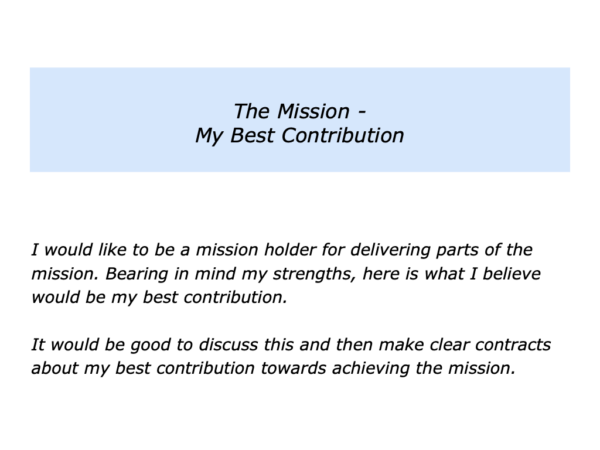
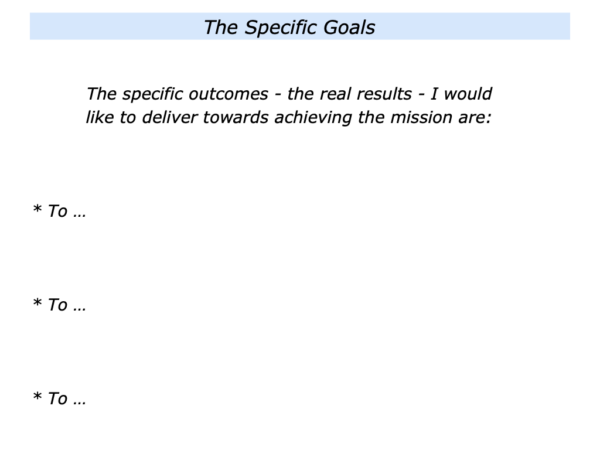
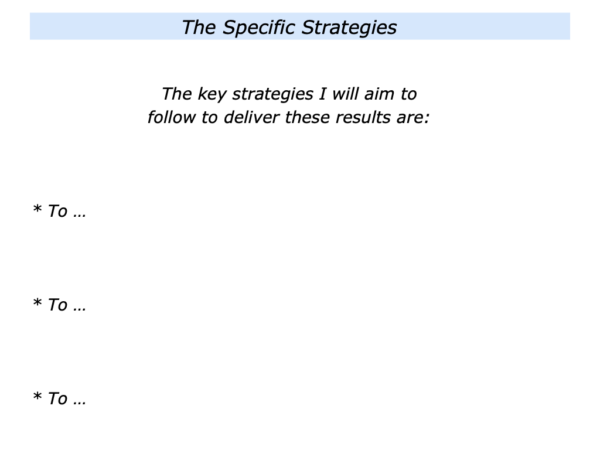
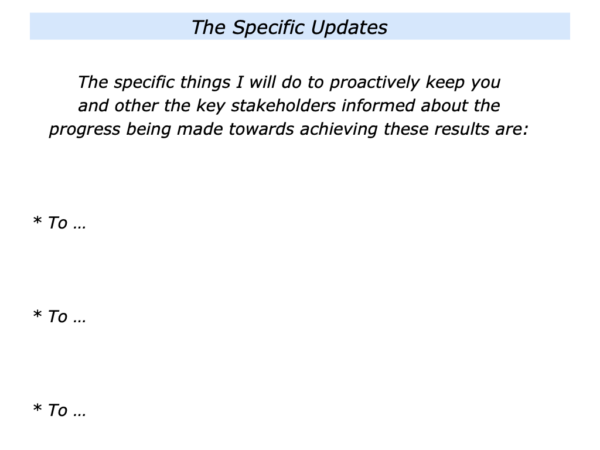
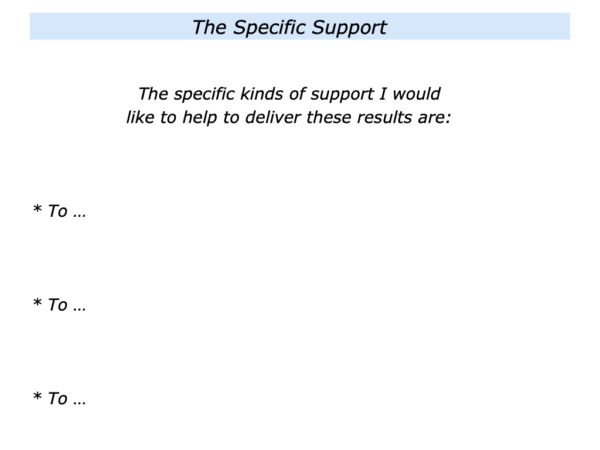
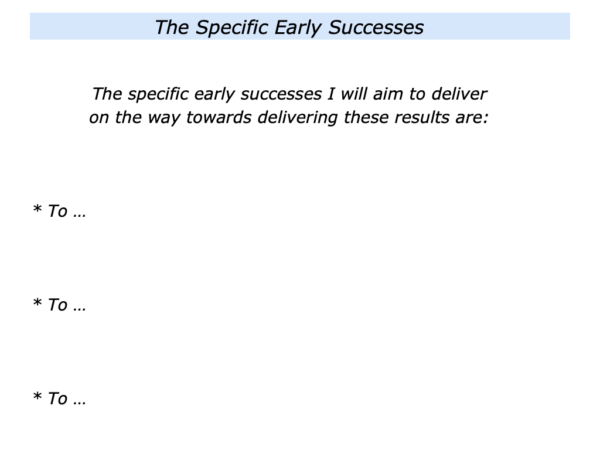
Let’s return to your own life and work. What are the key strategies you can follow to increase the likelihood of delivering your mission?
What are the specific things that must be done to deliver the mission? How can you continue to make sure the maintenance gets done?
If you wish, try tackling the exercise on this theme. This invites you to complete the following sentences.
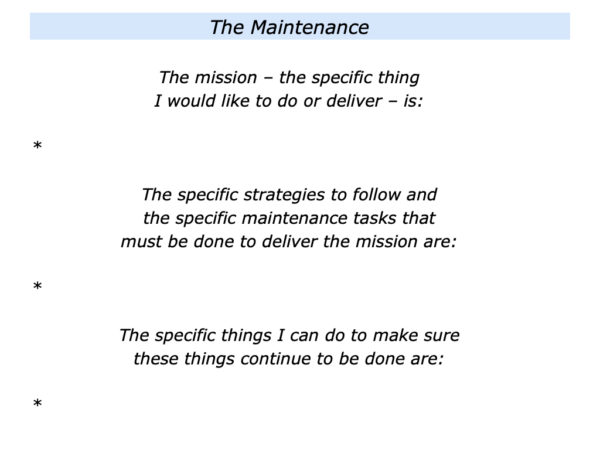
The Marvellous Work
Imagine you have delivered high standards when implementing the strategies and doing the maintenance. If appropriate, the next step is to do marvellous work.
Different people do this in different ways. You may go that extra mile to give great service, provide exceptional medical care or do something special to deliver success.
Sometimes it means knowing how to manage the moving parts. These can include: a) the predictable things that you know will be moving and developing; b) the potential unpredictable things that may be moving. It is to manage these and, if possible, aim to do marvellous work.
Imagine that you lead a team and want to encourage your people to take these steps. One approach is to invite them to do an exercise on this theme. You can introduce this in the following way:
“Great teams keep doing the maintenance. This is mandatory. Such teams maintain high standards and do what is necessary to deliver the mission.
“Good service providers, for example, build on the old idea of blending high tech and high touch. They get all the technical things right and also add the personal touch. They do something extra to help their customers achieve success.
“Bearing this in mind, I would like you to each write Post-it Notes describing the specific things that we may be able to add the marvellous work.
“We will then focus on how to do some of these things on the way towards delivering the mission.”
Depending on the kinds of work they do, different teams produce different ideas when doing this exercise. Here is a snapshot of some ideas that teams have produced.
Marvellous Work. The specific things
we can do to do marvellous work are:
To put the right people in the right places in the team … To get the casting right by putting the right people with the right customers … To encourage people to use their strengths to help our customers to succeed.
To keep delivering the scorecard – the mandatory things we must deliver to keep our bosses happy – and to also do stimulating projects that benefit the organisation … To build successful prototypes and produce success stories.
To create a stimulating environment that works for introverts – who like quiet spaces – and extroverts … To involve everybody in our regular monthly updates about the progress we are making towards achieving the mission.
To work with pacesetting customers – those who are tackling challenge that others will face in the future – and help them to find solutions to these challenges … To use this knowledge to produce our own future products and services.
To keep focusing on how we can follow the mission, do the maintenance and add the marvellous work … To do superb marketing that shows how we can help people to achieve success … To do this in a way that embodies our principles and delivers positive results.
There is another approach to encouraging people to focus on the mission. This sometimes involves certain people using their talents to go into another dimension to do marvellous and even magical work. Let’s explore this theme.
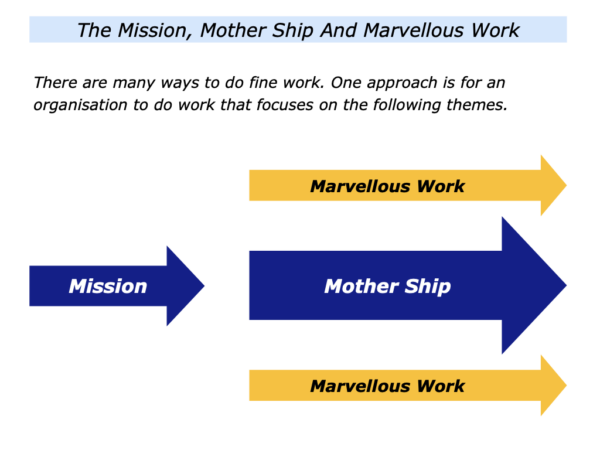
This approach was brought to life by the COO of a company. They described their challenge in the following way.
“I am in charge of the Mother Ship. Our job is to make sure the daily operations are on track. But we have a challenge.
“We have a visionary leader and several other key contributors who can sometimes create challenges. They are brilliant at what they do – such as selling or producing new technology.
“These people can add a lot to the company. It is important to encourage them to use their strengths and focus on the future, however, rather them diving into the overall operations.”
The COO managed the challenge by doing the following things. They agreed on the following steps.
Step One
This involved continually focusing on the company’s mission.
Step Two
This involved having superb people in the Mother Ship – the hub – who implemented the key strategies for achieving the mission.
Step Three
This involved everybody in the company aiming to do marvellous work. Sometimes this called for coordinating the work done some individuals and making sure it contributed towards achieving the mission.
The COO aimed to keep the Mother Ship on course. They also aimed to coordinate some people’s special talents in ways that contributed towards achieving the mission.
Let’s return to your own life and work. Looking ahead, can you think of a situation where you may want to follow the mission, maintenance and marvellous work approach?
What may be the mission you want to achieve? How can you do the necessary maintenance? How can you, when appropriate, do the marvellous work? What may happen as a result of taking these steps?
If you wish, try tackling the final exercise on this theme. This invites you to complete the following sentences.
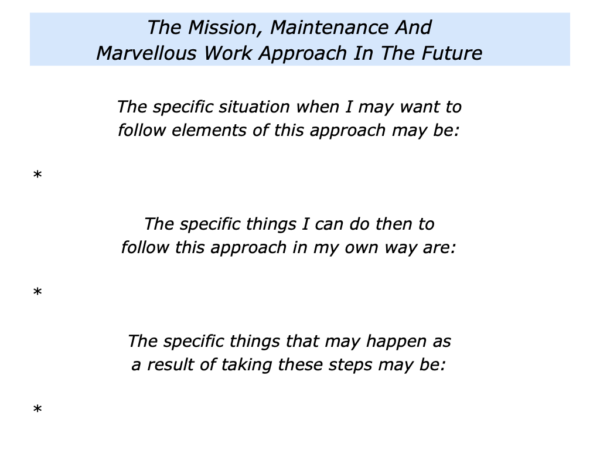


Leave a Reply